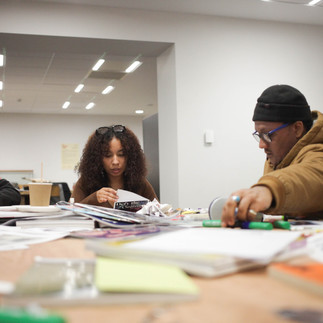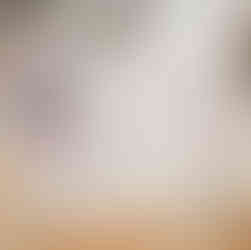The Legacies of DRUM Magazine at the "Make a Zine!" Workshop, Being Human Festival 2023
- Chris Turner

- Nov 21, 2023
- 4 min read
This blogpost is written by Chris Turner, a PhD researcher in English Literature at the University of Salford. Chris is part of the teaching team on our A-Level project and helped to facilitate our Being Human Festival zine-making workshop inspired by DRUM magazine.

Organisers of events for the Being Human Festival 2023 were asked to consider the concept of Rhyme or Reason, questioning how these two seemingly conflicting notions inform our social and political understandings, or even help us to learn from our mistakes. As their website suggests:
Sometimes our ideas may come from 'rhyme' (intuition, inspiration, the poetic or artistic). Sometimes they may come from 'reason' (evidence, empiricism, the logical or calculated). Sometimes the most visionary work comes from rhyme and reason working together, in synergy; sometimes it may seem as if there is neither rhyme nor reason, and yet meaning is still created.
Hosted at the fabulous Zine Maker Space and Salford Zine Library within the Clifford Whitworth Library, the "Make a Zine! (Inspired by DRUM Magazine)" workshop offered festivalgoers the unique opportunity to do just that: design and create their very own zine inspired by South African magazine, DRUM, a publication famous for its pioneering reporting of life under apartheid in the 1950s and 1960s. Introducing the event, Prof Jade Munslow Ong narrated the fascinating history of the publication, ably assisted by librarian and zinester Reis Tobolski, who familiarised us with the concept of the zine and gave us a crash-course in how to create our own. We quickly learned of the politically charged, activist spirit synergising both DRUM and the history of zines!
First established as The African Drum by cricketer and journalist Robert (Bob) Crisp during the early years of National Party rule, DRUM aimed to cater to an otherwise neglected Black African, Indian and ‘coloured’ readership with nostalgia-based articles centred around tribal life, religion, farming, folk tales, and African art/music. Run and owned by white men rather than DRUM’s key demographic, the magazine’s didactic and educational approach could easily be construed as patronising.
However, with the appointment of Henry “Mr Drum” Nxumalo, the publication would see a burgeoning of black journalistic talent that much better reflected the lives and outlook of its urban audience. Lewis Nkosi described them as “the new African[s] cut adrift from the tribal reserve – urbanised, eager, fast-talking and brash”. With its iconic bright and appealing covers featuring glamorous women, vibrant colours, and leading political figures, DRUM’s contents would start to take on a much more topical and political edge, reporting on gangs, crime, violence and gory murders alongside sport, jazz and art. Crucially, the magazine also documented a lot of the protest action and activism taking place in response to the apartheid government, making it a key source of such information that would be vital to the emerging nationalist movements.
So, what is it that makes the zine such an ideal medium with which to pay tribute to such a publication? As noted earlier, there is an irresistible synergy between the two, rooted in a very working-class, guerrilla-style activism. Although a zine can be used to convey information about practically anything (the fanzine, for example, provided the perfect medium for like-minded fans to discuss their favourite TV shows/books/sports etc. pre-internet), it has a longstanding reputation as the ideal medium for spreading views and opinions, particularly amongst under-represented and marginalised groups that would otherwise struggle to have their voices heard.
Armed with a multitude of coloured pens, pencils, stickers, scissors and a ginormous pile of magazines ready to be cut to ribbons, the suitably inspired attendees (myself included!) got straight to work on their own zines with gusto. The beauty of creating a zine lies in its simplicity, making the process remarkably accessible. Once you have folding technique for your A3 sheet of paper down, you are good to go!
The following three hours flew by with a flurry of activity, with only the occasional pause made to indulge in the rather excellent spread of teas, coffees, donuts and pastries. The shared exercise provided a delightful sense of community, as everyone came together to discuss their work and the inspiration behind it, passing our zines around one another in the process. It was amazing to see the multitude of different reactions that everybody had towards the overarching concept reflected in the zines produced, many expressing themes of racial equality, feminist representations of women, and the political atmosphere of apartheid South Africa. Some were inspired by the variety of short stories published in DRUM, whilst others paid tribute to the striking imagery it regularly contained. It was clear that the material had struck everybody attending on a multitude of levels and in many different ways.
The completed zines were placed inside the free vending machZine in the library or otherwise hidden in various related books around the library for readers to discover.
Reflecting on the theme of this year’s festival, I would suggest that those of us who attended ultimately made ‘Rhyme FROM reason’: taking inspiration and creating art from a publication that reflected an oppressive political backdrop for those who brought it to life whilst ultimately taking refuge in it. As DRUM photographer Peter Magubane stated:
"DRUM was a different home; it did not have apartheid. There was no discrimination in the offices of DRUM magazine. It was only when you left DRUM and entered the world outside of the main door that you knew you were in apartheid land. But while you were inside DRUM magazine, everyone there was a family".
You can find an online library of the zines here.
We would like to thank the Being Human Festival team, AHRC and British Academy for funding the event, and Reis Tobolski and Alex Mitchell at the Clifford Whitworth Library for their advice and support. Photography and films by Maham Safdar, Charif Assad, Ariij Asif and Emma Barnes.














































Comments